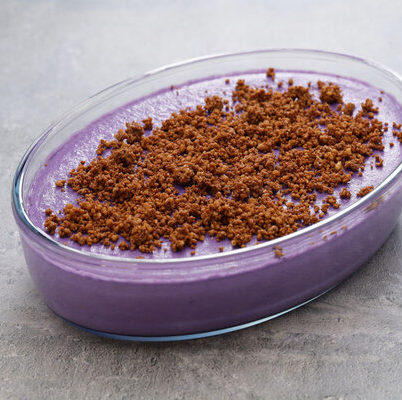
Ube Halaya
also known as Ube, Purple yam
What is Ube Halaya?
Ube halaya (Dioscorea alata) is a species of yam. This tuberous root vegetable should not be confused with sweet potatoes. Yams are part of the family Dioscoreae, whereas sweet potatoes are from the genus known as Convolbulaceae.
- Ube halaya has a grey-brown skin with purple-colored flesh, and when cooked, has a soft texture.
- Also, ube has a sweet and nutty flavor.
The top 8 most common varieties of yam are:
- American Yam
- Filipino Yam (Ube)
- Tropical Yam
- Japanese Mountain Yam
- Chinese Yam
- White and Yellow Yam
- Lesser Yam
- Okinawa Yam
Origin of ube halaya
This food is believed to have originated in the Philippines, where it is the main ingredient in a popular jam. In 1613, the first Tagalog and English dictionary included this purple yam, and was the first written description of the vegetable. Later on, in 1898, when the Americans brought condensed milk to the Philippines, sweeter recipes for this purple yam began to crop up. The creamy, sweet, and delicious desserts this yam makes are a favorite for Philipinos and many people worldwide. In fact, ube is a more popular ice cream flavor than vanilla in the Philippines.
Function
Ube Halaya can be transformed into several tasty desserts. These include cookies, cakes, flan, and pancakes. However, this yam is sweet enough to also be a tasty filling for pastries.
Nutrition
A 100g serving of this dish has the following nutritional value:

It is a powerhouse of vitamins, minerals, as well as antioxidants. Studies show that the antioxidants in this yam can help reduce oxidative stress. In addition, research suggests that ube may help lower blood pressure. This root vegetable may also aid digestion and improve symptoms of asthma.
Commercial production
The commercial production of ubi (or the water yam) produces ube halaya. The ubi vine thrives in sandy loam or silt loam fertile soil. Also, it requires temperatures between 77°F-80°F and plenty of moisture. This crop can grow during any time of year. After six months, the vine produces tubers which can be harvested.
Application
To prepare ube halaya at home, first wash and cook the yam. Then, add together evaporated milk, condensed milk, sugar, coconut milk, butter, salt, vanilla and lemon juice. Make sure the sugar dissolves, and add the cooked ube. After that, put the mixture on heat and stir continuously. When the mixture thickens add butter and allow to cool before eating. Store any leftovers in the fridge for 3-5 days.
Ube halaya recipes
Ube is a sweet and versatile ingredient. Here are some recipes to try:
FDA regulation
The Food & Drug Administration has no standard of identity for ube halaya. However, the FDA does inspect all imported goods to ensure they are safe, sanitary, and labeled correctly.
References
Valdeavilla, Ronica. “Purple Yam Ice Cream Is a More Popular Flavour Than Vanilla in This Asian Country.” Culture Trip, The Culture Trip, 6 June 2018, theculturetrip.com/asia/philippines/articles/ube-the-philippine-purple-yam-more-popular-than-vanilla/.
Zhang, Megan. “Travel – Ube: The Filipino Tuber Taking over the World.” BBC, BBC, 4 Feb. 2021, www.bbc.com/travel/story/20210203-ube-the-filipino-tuber-taking-over-the-world.
Susan, McCabe, BSc, RD. “7 Benefits of Purple Yam (Ube), and How It Differs from Taro” Healthline.com, on May 16, 2019, https://www.healthline.com/nutrition/ube-purple-yam
